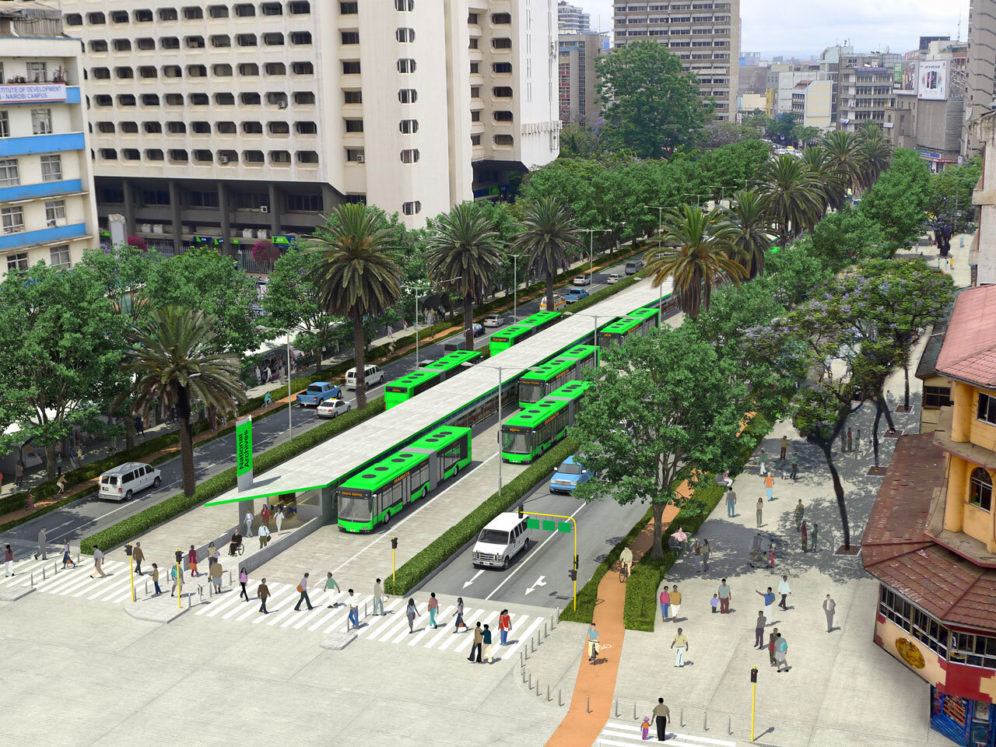
August 08, 2022
Kenya’s next government ought to prioritise sustainable transport
The upcoming general elections in Kenya will be key in determining the country’s direction and investment plan over the next five years. At the forefront of the issues facing the country is the question of the high cost of living driven in large part by the rising price of fuel. In order to ensure access to opportunities in Kenyan cities, there is an urgent need to invest in accessible and affordable modes of transport.
Given that a majority of urban Kenyans walk or use public transport as their main commute modes, all urban areas in the country need efficient public transport complemented by adequate walking and cycling facilities. Currently, public service vehicles operate with minimal government regulation and passengers face poor-quality services. Matatus and buses are stuck in traffic jams, resulting in long and arduous commutes for the large portion of commuters who depend on public transport: 41 percent in Nairobi and 36 percent in Mombasa.
To improve the efficiency of public transport and free buses from congestion, we need to upgrade service on high-demand corridors through bus rapid transit (BRT). BRT is a high-quality bus-based transit system that delivers fast, comfortable, and cost-effective service at metro-level capacities. BRT can improve access to opportunities, cut pollution, and assist existing PSV operators in becoming world-class public transport service providers. In Dar es Salam, the successful DART BRT has cut travel times more than 50 percent for 200,000 daily users.
The Nairobi Metropolitan Area Transport Authority (NaMATA) has gazetted five BRT corridors in the city. In order for BRT systems to meet their full potential, they must incorporate features that contribute to system performance, including median-aligned bus lanes; level boarding from centrally aligned stations; passing lanes; and off-board fare collection. There is a need for an immediate review of ongoing road projects in urban areas in the country to ensure compatibility with BRT plans. In future, all upcoming projects should consider mass rapid transit.
Reform in the public transport business model is critical. Currently, matatu crews face long hours for low and unstable pay with no benefits. In many cases the poor operating environment leads to dire road safety risks: drivers speed to maximise revenue from passenger fares, leading to crashes. Commercial imperatives, rather than convenience for passengers, have driven the arrangement of matatu routes: almost all routes originate from city centres. The existing arrangement makes cross-town trips more expensive and time-consuming. Nairobi and other cities can introduce cross-town routes to reduce the need for transfers.
To improve operating conditions, all buses/matatus should operate under a service contract between the operating cooperative or company and the government. A service contract defines the relationship between government and the bus company. It allows the government to determine the quality of service, and at what price. Fare collection should be handled by an independent service provider that is answerable to the government, with electronic fare verification using smart cards. Operators should be paid based on a formula that is heavily weighted on a fee per kilometre operated, making it possible to incentivise bus companies to follow their assigned schedules instead of waiting until vehicles are full.
County governments and road agencies need to ensure that there are high-quality, accessible shelters at all bus stops and terminals. Due to a lack of terminals and depots, matatus are parked and maintained on roadsides and other informal parking areas, which further affects the quality of service. Terminals and bus shelters should include lighting and protection from rain and sun and should be sized to the level of demand. Vending in these areas should be organised in order to maintain clear passageways for passengers. Bus shelters can be implemented through a public-private partnership arrangement in which a private party instals the shelters in return for receiving advertising revenue.
To complement investments in public transport, Kenyan cities need better facilities for walking and cycling. Walking accounts for the largest share of trips in Kenyan cities (40 percent of trips in Nairobi, 45 percent in Mombasa, and 52 percent in Kisumu), yet many streets lack provision for pedestrians and cyclists. Some Kenyan cities have a few scattered segments of usable cycle tracks, making it difficult for potential cyclists to find safe routes to their destinations. Many commuters would shift to cycling if urban areas had complete networks of dedicated cycle tracks.
Streets that prioritise active modes and public transport are more dynamic and create more opportunities for trade and business. All street upgrades should be designed per the Street Design Manual for Urban Areas in Kenya. Improvements should prioritise locations with high pedestrian and cyclist volumes and areas around public transport hubs. City streets need high-quality, unobstructed, and accessible pedestrian footpaths to provide basic mobility for all. Furniture, streets lined with trees, and active building edges transform walkways into vibrant spaces.

Political will and leadership are key factors in the drive to implement efficient, affordable, and sustainable urban transport. Kenya’s upcoming urban transport investments will influence core issues such as the cost of living, public health, greenhouse emissions, and overall livability. To achieve equality and socio-economic prosperity, it is crucial that we have an integrated and inclusive approach to urban planning anchored by investments in sustainable transport.
